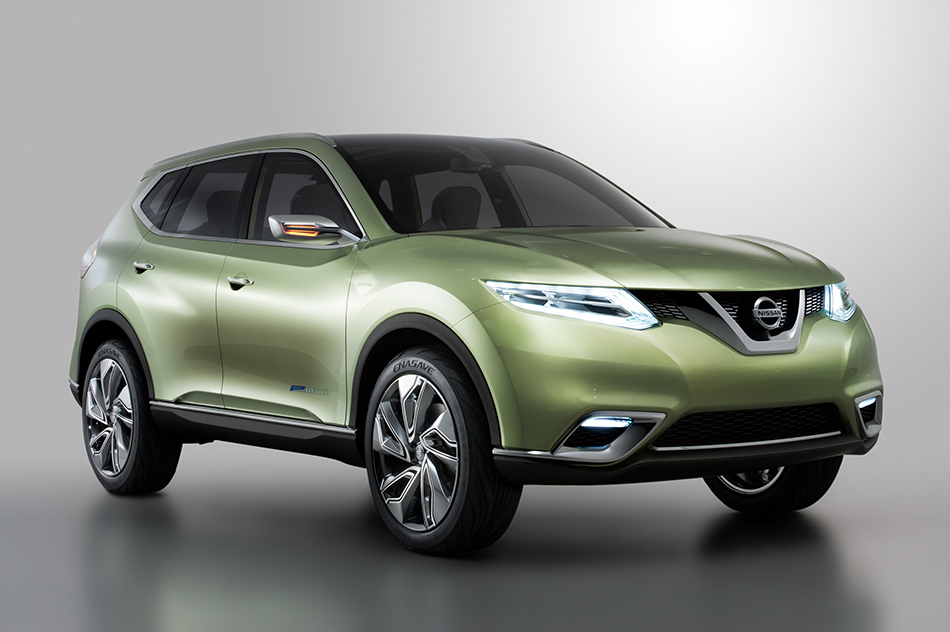The Nissan Hi-Cross Concept, which makes its North America debut at the 2012 Los Angeles Auto Show, offers a bold design statement about the next-generation of Nissan crossovers. The design is dramatic and athletic, yet completely purposeful. The dimensions are compact, yet surprisingly roomy. And, it's fuel efficient. The concept's hybrid drivetrain is based on a new Nissan system developed for front- and four-wheel-drive models.
"Nissan established crossover design leadership from the introduction of the highly original Nissan Murano by exploring new ideas and concepts and implementing them on a production vehicle," said Al Castignetti, vice president and general manager, Nissan Division, Nissan North America, Inc. "The Hi-Cross Concept stretches the compact SUV envelope in design and technology, while remaining pure to Nissan's family adventure vehicle spirit."

A "High-Riding" Crossover Appearance
Though the Hi-Cross name reflects the advanced concept's unambiguous purpose as a traditional Nissan adventure-ready sport utility, the "Hi" also fits the exceptional innovation and excitement promised by the unique crossover design. Built on a 109.4-inch wheelbase with a 183.5-inch overall length, the Hi-Cross Concept offers seven-passenger seating within its compact dimensions thanks to short front and rear overhangs, compact HEV drivetrain and efficient packaging.
The styling combines existing Nissan design cues with new elements. For example, at the front it has a characteristic V-shaped Nissan grille set off by distinctive lighting signatures provided by the shapely headlamps. The narrow, deeply tapered LED headlamps combine with the curved hoodline, fully flared fender lines and large 10-spoke 21-inch aluminum-alloy wheels to help provide a tall yet muscular stance. A progressive new crossover design language is showcased, in particular, by the bold character line that extends from the hood down the high-waisted bodyside to the D-pillar. At the rear, the Hi-Cross Concept has distinctive lighting signatures provided by stylish trapezoidal LED taillamps that echo the headlamp design, along with a sculpted rear hatchback and extended rear roof spoiler. Fog lamps and a deep custom Aurora Green paint treatment complete the dramatic exterior design.
Inside, the roomy interior features three rows of seating for seven occupants – deep, wide front bucket seats, a split fold-down 2nd row bench and a comfortable 3rd row fold-down bench. Along with ample headroom for all rows, thanks in part to the Hi-Cross Concept's tall, flat roofline, the 2nd and 3rd rows fold down into a large flat floor for carrying cargo. The Hi-Cross Concept's T-wing shaped instrument panel offers Fine Vision multi-dimensional gauges and a large central information display, bringing an elevated sense of connection for the driver and front passenger. A sculpted center console completes the T-wing shape and matches the deep-cut, two-tone door panels and elegantly styled steering wheel.
"The Hi-Cross Concept interior design is far more practical than most show car interiors, displaying a more realistic view of what crossover customers are looking for in the real world – style plus efficiency, clever but practical features and an enhanced driving experience," added Castignetti.
The Power of Fresh Thinking
Just as the Hi-Cross Concept interior offers a roomy interior within its modest exterior proportions, the advanced drivetrain provides the power of a larger 2.5-liter engine with the efficiency, reduced emissions and design flexibility of a smaller 2.0-liter unit.
"The power behind Nissan's brand philosophy, 'Innovation that excites,' comes from our dedication to continuously exploring new ideas," said Castignetti. "Coupling an electric motor – powered by a Nissan-developed compact lithium-ion battery similar to that utilized in the Nissan LEAF electric vehicle – with a 2.0-liter direct injection gasoline engine is another great example of the smart technology behind every Nissan."
The system's innovative approach to affordability and packaging adopts "one-motor, two clutch" technology. The first of the two clutches is installed between the 2.0-liter engine and the electric motor. It facilitates full decoupling of the gasoline engine when the car is in electric drive and power regeneration modes. The second clutch, located behind the transmission, helps smooth the transition. Decoupling the engine reduces mechanical losses and boosts efficiency of the electric motor. In city driving, for example, the presence of the electric motor and lithium-ion battery allow the engine to be turned off frequently. It can also be disengaged completely with the clutch and energy can be recovered effectively when braking.
This advanced hybrid system is linked to Nissan's next-generation Xtronic CVT® (Continuously Variable Transmission). The low-friction CVT design, used on the recently introduced 2013 Nissan Pathfinder, has smaller shaft-diameter pulleys to provide the widest possible ratio coverage for enhanced efficiency.
The hybrid drivetrain also makes extensive use of battery technology developed for the award-winning Nissan LEAF. The high output, fast-charging compact lithium-ion battery, linked to high-level motor control technology, provides acceleration assist when needed and permits downsizing of the gasoline engine for optimum economy and emissions.
"Though just a design exercise today, the Hi-Cross Concept offers an exciting blueprint for a future production Nissan crossover. It's an idea well worth exploring," added Castignetti.
Source: Nissan






















